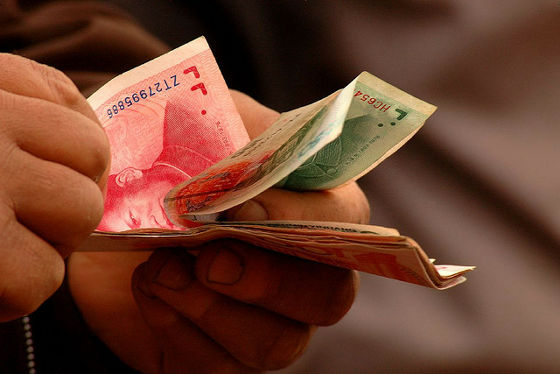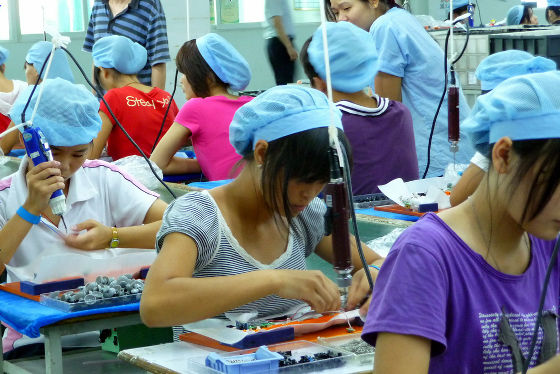What is the world going to be going for 2050 with the end of China's low-wage labor force?

ByCarlos Adampol Galindo
In November 2015, China finallyOne child policyHas been abolished. It was China, which became the world's largest exporter owing to its inexpensive labor, but it is expected to gradually decline the labor force for various reasons in the future. From now on until 2050, we will see how the shape of manufacturing in China and the world will change, based on an American based apparel manufacturerLevi'sFor example, the Wall Street Journal shows its view.
As China's Workforce Dwindles, the World Scrambles for Alternatives - WSJ
http://www.wsj.com/articles/as-chinas-workforce-dwindles-the-world-scrambles-for-alternatives-1448293942
Founded in 1853 Levi tries to manufacture jeans only in the United States until 1960. However, in order to lower the manufacturing cost, starting with production in Hong Kong in 1966, it also advanced to Mexico, Europe and Asia. And from around 1986 we will move our factory to China.
China has increased the product shipment to overseas by 6700% from 1980 to 2007 by using the large amount of labor and became the world's largest exporter by the United States. In the factories in the US and Europe, we had a strategy to lower costs by using machinery to automate work, but the embarrassment of the Chinese labor force at that time was "not able to win the machine", Vice President of Levi's "David Love says. In China in the second half of 2002Labor costIt is said that it was 60 cents per hour (about 74 yen).

ByKen Driese
However, Levi, which had been manufacturing at a factory in China and lowering the cost, has been reviewing the supply chain in recent years. China's production age population growth has peaked, so calledPopulation BonusThe end is starting to appear. As of 2012, China's production age population is about 930 million people, but the United Nations's view is that by 2050 the production age population will decrease by 221 million people. The figure of 212 million people is roughly the same as the total population of Brazil.
Changes in the production age population from 15 to 59 in China are as follows. The blue part on the left is the actual number until around 2011, and the light blue part is predicted by the United Nations. The production age population of China shows the trend of decreasing for the first time in 2012, and this trend is considered to accelerate from now on.

In addition, as the current production age population ages, it is thought that the population over 60 years old in 2050 will be about twice the year 2015, the population migrating from the city to the country to increase care to look after parents has increased There is also the possibility that the labor force in urban areas will decrease.
Furthermore, the sudden rise in inexpensive wages is one of the reasons why we can not produce the labor force as we have been. In the past, the labor cost per hour was about 74 yen, but now the coastal labor cost is 15.6 dollars per hour (about 1900 yen), the US $ 22.68 (about 2800 yen) There is no big difference even compared with. Although the economy is expected to gradually become gentle as the economy slows down, wage increases are unavoidable over the next several decades.
The red line at the bottom of the graph below shows the rise in wages in China.

A 28 year old young man working in Nansha Ward, China earns his living by assembling boards, etc., but has earned enough annual income to buy a house. The young man said, "There are various opportunities now, I want to do what I can do well, so if you have the opportunity to work on batteries, I definitely want to challenge."
Just because China's labor costs rose, Levi's did not raise the price. So, how to reduce costs is the key to the introduction of machinery in factories in China. Levi introduces a laser that can etch different patterns so that each denim looks like a different design, "the work of sewing the needle in the pattern of the pocket", "Complex which was drawn one by one by hand Drawing patterns "was also mechanized with automatic sewing machines and digital printers. Furthermore, it seems that the cost is suppressed by reducing the number of suppliers to 60% so far, by halving the amount of dough purchased.

The sales of industrial robots in China are overstretched and are expected to rise in the future.

In order to further reduce costs, Levi sometimes manufactures in Cambodia etc. whose labor cost is lower than that of China, furthermore, Levi is also paying attention to African countries where the labor cost is cheaper and the population of young people is large.
In addition, in recent years, the form "to manufacture according to the taste of each consumer" is becoming mainstream, not only the change in the domestic market, but also the change itself in the form of manufacturing and consumption itself. It is already realized that "Various goods can be easily purchased on the Internet" at Levi's, and now it is "perfect for each person by consumers scanning his / her body and uploading the numerical value of each part An attempt to purchase clothes "is underway.
By these changes, the form of manufacturing "exporting products mass-produced at a huge factory in the coastal area of China" to overseas has changed, and the form that manufactures products tailored to the taste of each region in a small factory It is seen that it will increase. Actually, Skinny jeans, which were manufactured in China and have caused a boom in Europe, had unexpected hits in Poland and Turkey, so now there are small factories in both countries.
The graph below shows that China 's export volume peaks in 2017 and thereafter it expects to gradually reduce export volume.

According to the Wall Street Journal, due to these manufacturing changes, the trade deficit with the United States of America is predicted to be in the black by 2042. Furthermore, 15 years ago, in Mexico's Levi where 6000 employees were dismissed without being able to overcome China's production age population and wage cheapness, it seems that Mexico's Levi's will have to work again as China's production age population declines and wages rise It is expected that it is not.

ByChris
In recent years, as the technology of 3D printers has improved and the price has become cheap, "3D printers will make clothing, food and equipment, etc. by 2050 and the form of manufacturing will change dramatically" There are also engineers who think that. Based on these, the Wall Street Journal will come to be selected more personalized, fast arrival of goods, environmentally friendly one from the form of mass production and mass consumption, and so on I expressed my opinion.
Related Posts:
in Note, Posted by darkhorse_log







